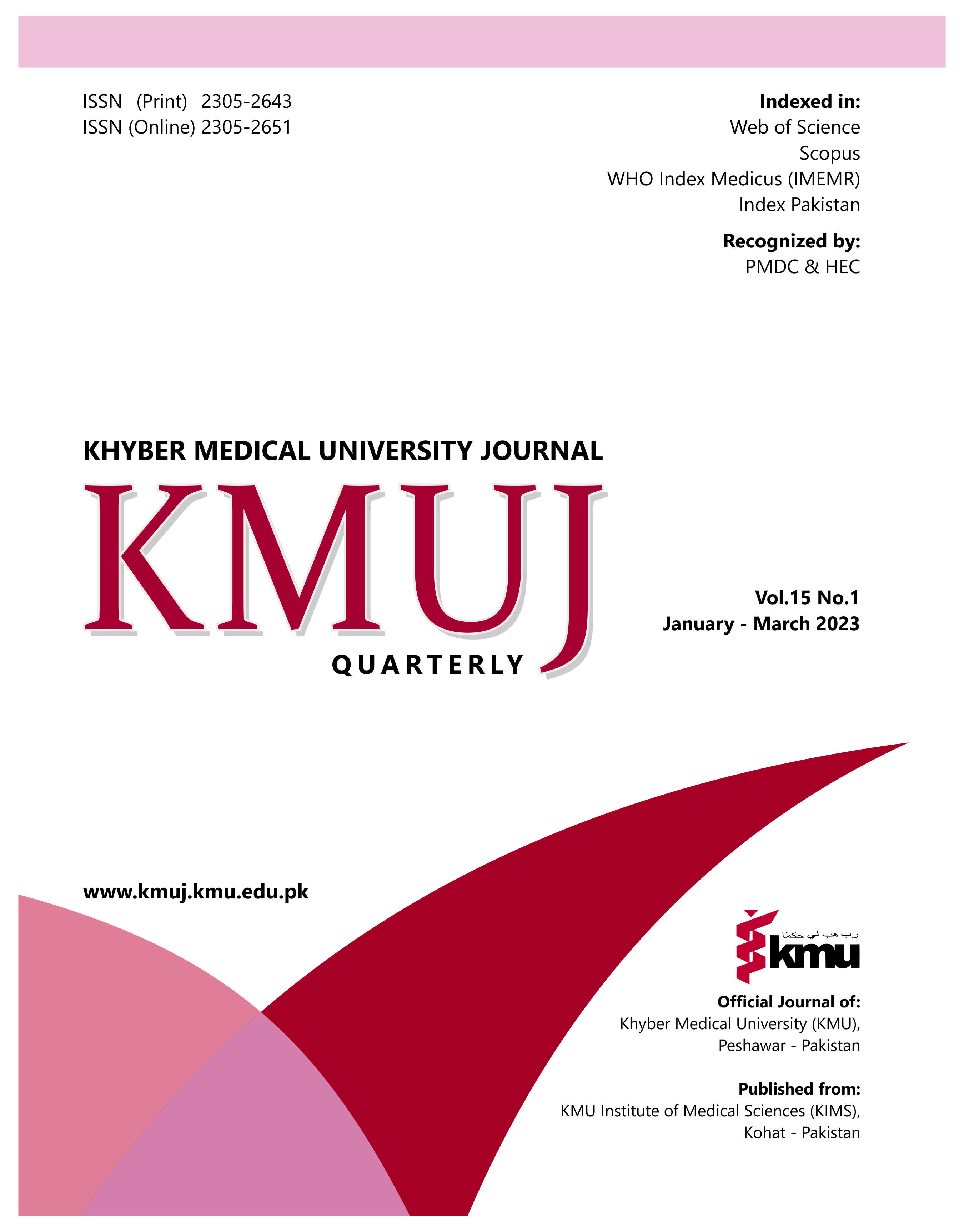DIAGNOSTIC ACCURACY OF PLAIN MAGNETIC RESONANCE IMAGING OF CRUCIATE LIGAMENTS AND MENISCAL INJURIES KEEPING ARTHROSCOPY AS GOLD STANDARD
Main Article Content
Abstract
OBJECTIVE: To find out the accuracy of plain Magnetic Resonance imaging (MRI) in comparison with arthroscopy in diagnosing cruciate ligaments and meniscal injuries.
METHODS: This prospective study was conducted from June 2019 to June 2020 at Khyber teaching hospital Peshawar, Pakistan. All patients, aging 14-55 years, with history of trauma to knee and suspected meniscal and ligament injuries were included. Patients with positive findings on clinical examination and MRI were sent for arthroscopy. Findings on MRI and arthroscopy were compared for diagnostic accuracy.
RESULTS: Out of 100 patients, 87 were males. Fifty-nine patients had anterior cruciate ligament injuries (ACLI), one patient had posterior cruciate ligament injuries (PCLI), 49 patients had medial meniscus injuries (MMI) and 8 had lateral meniscal injuries (LMI) respectively. Sensitivity, specificity, positive predictive value (PPV) and negative predictive value (NPV) of MRI was 93.4%, 71.4%, 82.35% & 88.23% respectively for ACLI and 100%, 96%, 20% and 100% respectively for PCLI. Similarly, sensitivity, specificity, PPV and NPV of MRI was 81.6%, 45.3%, 57.97% & 72.72% respectively for MMI and 37.5%, 91.5%, 27.27% and 94.5% respectively for LMI. There was no statistically significant difference for gender (p=0.43) and side of knee (p=0.22) between MRI vs arthroscopy.
CONCLUSION: MRI has high sensitivity and NPV for ACLI & PCLI, low sensitivity for LMI, low specificity for MMI and low PPV for PCLI, MMI and LMI. In cases of clinical suspicion of meniscal or ligamental injury, clinicians should not rely on MRI findings alone but should follow it up with diagnostic arthroscopy.
Article Details
Work published in KMUJ is licensed under a
Creative Commons Attribution 4.0 License
Authors are permitted and encouraged to post their work online (e.g., in institutional repositories or on their website) prior to and during the submission process, as it can lead to productive exchanges, as well as earlier and greater citation of published work.
(e.g., in institutional repositories or on their website) prior to and during the submission process, as it can lead to productive exchanges, as well as earlier and greater citation of published work.
References
Barry KP, Mesgarzadeh M, Triolo J, Moyer R, Tehranzadeh J, Bonakdarpour A. Accuracy of MRI patterns in evaluating anterior cruciate ligament tears. Skeletal Radiol 1996;25(4):365-70. https://doi.org/10.1007/s002560050096
Barber-Westin SD, Noyes FR. Factors used to determine return to unrestricted sports activities after anterior cruciate ligament reconstruction. Arthroscopy 2011;27(12):1697-705. https://doi.org/10.1016/j.arthro.2011.09.009
De Smet AA, Graf BK. Meniscal tears missed on MR imaging: relationship to meniscal tear patterns and anterior cruciate ligament tears. Am J Roentgenol 1994;162(4):905-11. https://doi.org/10.2214/ajr.162.4.8141016
Arnoldi AP, Weckbach S, Nussbickel C, Horng A, Nöbauer I, Zysk S, et al. [MRI based volumetric assessment of knee cartilage after ACL-reconstruction, correlated with qualitative morphologic changes in the joint and with clinical outcome. Is there evidence for early posttraumatic degeneration?]. Rofo 2011;183(12):1138-44. https://doi.org/10.1055/s-0031-1281685
Logan MC, Williams A, Lavelle J, Gedroyc W, Freeman M. Tibiofemoral kinematics following successful anterior cruciate ligament reconstruction using dynamic multiple resonance imaging. Am J Sports Med 2004;32(4):984-92. https://doi.org/10.1177/0363546503261702
Lee JK, Yao L, Phelps CT, Wirth CR, Czajka J, Lozman J. Anterior cruciate ligament tears: MR imaging compared with arthroscopy and clinical tests. Radiology 1988;166(3):861-4. https://doi.org/10.1148/radiology.166.3.3340785
De Smet AA, Tuite MJ, Norris MA, Swan JS. MR diagnosis of meniscal tears: analysis of causes of errors. Am J Roentgenol 1994;163(6):1419-23. https://doi.org/10.2214/ajr.163.6.7992739
Dandy DJ. The impact of arthroscopic surgery on the management of disorders of the knee. Arthroscopy 1990;6(2):96-9. https://doi.org/10.1016/0749-8063(90)90006-y
Quinn SF, Brown TF. Meniscal tears diagnosed with MR imaging versus arthroscopy: how reliable a standard is arthroscopy? Radiology 1991;181(3):843-7. https://doi.org/10.1148/radiology.181.3.1947108
Deutsch A, Mink J, Fox J, Arnoczky S, Rothman B, Stoller D, et al. Peripheral meniscal tears: MR findings after conservative treatment or arthroscopic repair. Radiology 1990;176(2):485-8. https://doi.org/10.1148/radiology.176.2.2367665
Quinn SF, Brown TF. Meniscal tears diagnosed with MR imaging versus arthroscopy: how reliable a standard is arthroscopy? Radiology 1991;181(3):843-7. https://doi.org/10.1148/radiology.181.3.1947108
De Smet AA, Norris MA, Yandow DR, Graf BK, Keene JS. Diagnosis of meniscal tears of the knee with MR imaging: effect of observer variation and sample size on sensitivity and specificity. Am J Roentgenol 1993;160(3):555-9. https://doi.org/10.2214/ajr.160.3.8430552
Garneau RA, Renfrew DL, Moore TE, el-Khoury GY, Nepola JV, Lemke JH. Glenoid labrum: evaluation with MR imaging. Radiology 1991;179(2):519-22. https://doi.org/10.1148/radiology.179.2.2014303
Yousem DM, Atlas SW, Hackney DB. Cervical spine disk herniation: comparison of CT and 3DFT gradient echo MR scans. J Comput Assist Tomogr 1992;16(3):345-51.
